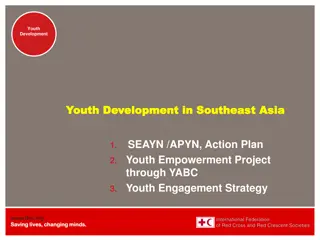Custody as a Last Resort: Youth Justice Service Report
The report emphasizes the need to avoid unnecessary criminalization of under-18s and highlights the detrimental impact of custody on vulnerable children. It discusses the over-representation of Black, Asian, and Minority Ethnic children in custody and the lack of evidence supporting custody as a means of rehabilitation. Characteristics, impact, and disproportionality in custody are also examined.
Download Presentation

Please find below an Image/Link to download the presentation.
The content on the website is provided AS IS for your information and personal use only. It may not be sold, licensed, or shared on other websites without obtaining consent from the author.If you encounter any issues during the download, it is possible that the publisher has removed the file from their server.
You are allowed to download the files provided on this website for personal or commercial use, subject to the condition that they are used lawfully. All files are the property of their respective owners.
The content on the website is provided AS IS for your information and personal use only. It may not be sold, licensed, or shared on other websites without obtaining consent from the author.
E N D
Presentation Transcript
Custody as a Last Resort YOUTH JUSTICE SERVICE
Background & Rationale: The Standing Committee for Youth Justice (SCYJ) is an alliance of over 60 not for profit organisations working to improve the youth justice system in England & Wales. In May of this year they produced a report emphasising the need to avoid criminalising under-18s unnecessarily. The principle that custody should only ever be used as a last resort for children is enshrined in domestic law and international human rights conventions, but is not consistently applied as such. It also highlighted the worrying trend that as the number of children in custody has declined, the over-representation of Black, Asian and Minority Ethnic (BAME) children has worsened to the point that 2019 saw more BAME children in custody than white children for the first time.
Impact of Custody: Whilst children in custody are considered to pose significant risk, they are often also our most vulnerable children, and placing them in custody exposes them to further Adverse Childhood Experiences, exacerbating and further compounding these vulnerabilities. Custody is irrefutably incompatible with clear evidence on desistance from offending. Research shows that children s developmental needs cannot be met in a custodial environment, and there are significant risks of children suffering emotional, psychological and physical harm, as well as clear long term impacts on education, employment, family life, mental health and well-being. There is no evidence to support the use of custody as effectively contributing to rehabilitation or promoting positive long term outcomes. The report goes on in detail to evidence the harmful impact custody can have on our children.
Characteristics of Children in Custody: Boys are significantly over-represented in custody, with over 97% of the child custody population being boys. Around half (52%) of children in custody have been in care. Majority of children entering custody are NEET or simply not accessing education provision. It s estimated that 90% have a history of persistent absence and exclusions. Around a third of children in custody have a learning disability or Special Educational Needs. Trauma is a prevalent amongst children in custody, with about a third having recognised mental health concerns. Around 45% have substance misuse issues/concerns. About 60% in the wider cohort to include those on custodial sentences have speech, Language and communication difficulties.
Disproportionality: Despite the promising downward trend in the use of custody, which is documented as a decrease by 78% between 2008 2019, it is of concern that as the number of children in custody has declined, the rate of decrease has been slower for Black, Asian and Minority Ethnic (BAME) children. Disproportionality has therefore worsened, with 2019 reporting more BAME children in custody than white children for the first time.
Local Picture: Despite numbers of Tameside children in custody being low, we can t ignore these children Between July 19 and June 20 4 young people from Tameside received custodial sentences All male, between the ages of 16/17 All serving sentences of 12 months or more 3 out of the 4 males were from BAME backgrounds.
So what are we doing and what more can be done? Statutory duty to safeguard and promote the welfare of our children. Increased focus and resources aimed at early intervention and prevention. Appropriate use of diversionary practice (Innovation). Multi-agency/partnership approach. Highly qualified team of practitioners trusted relationship model . Child first offender second There is a call for an expansion of high quality community provision to ensure that the needs of the cohort are met in a community setting and that public protection is maximised. Local Authorities and their partners to look to provide services which support the management of children without the need for incarceration.























